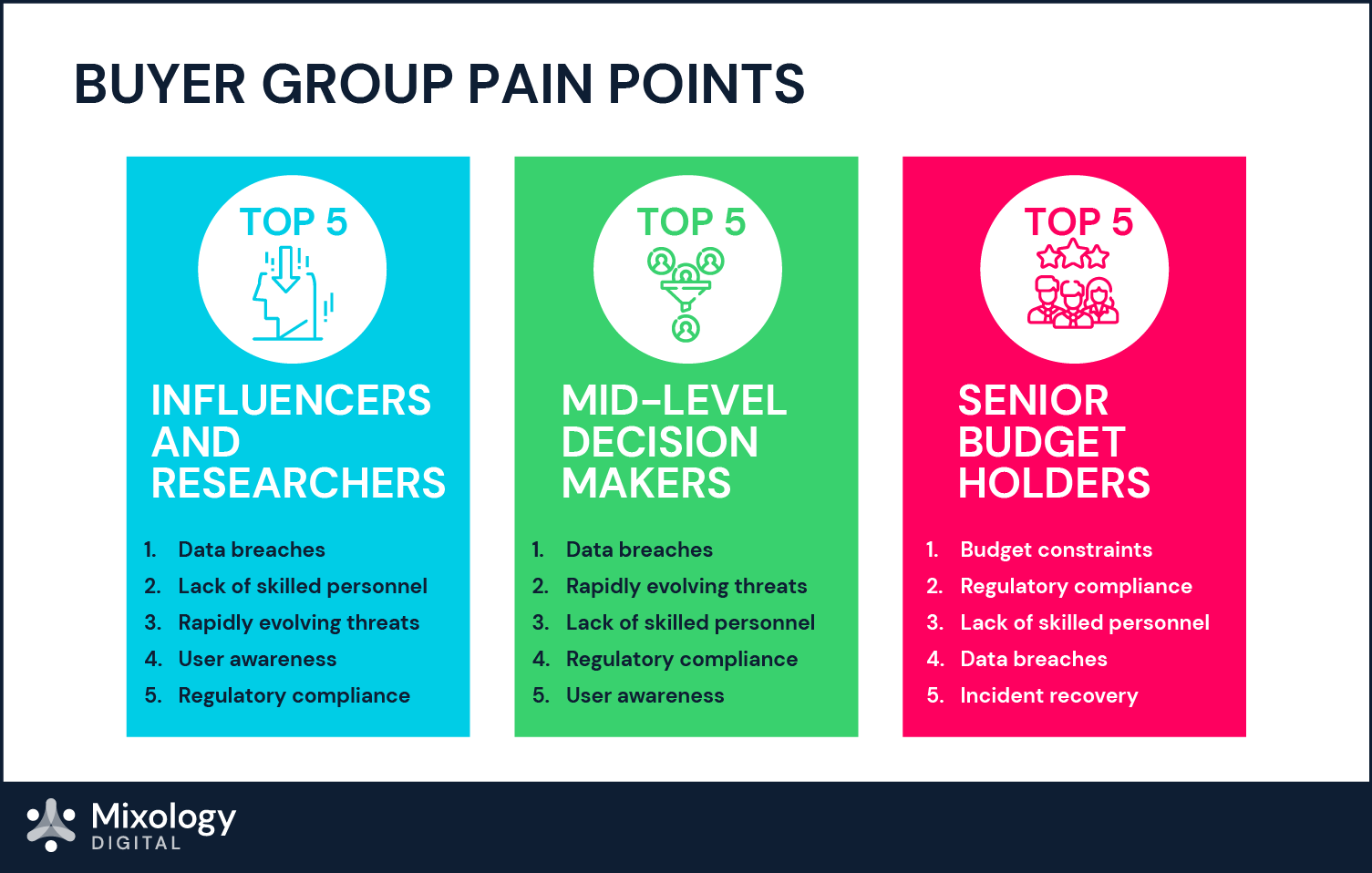Read time: 7 minutes
What’s been happening in the cybersecurity sector over the last 3 months?
Our Buyer Intelligence platform has been continuously tracking first-party buyer signals across our database, bringing you timely insights in the form of our latest cybersecurity intent report.
Our mission? To help tech vendors keep their demand generation strategies tightly aligned to real market demand.
Published quarterly as part of our category-specific intent reports, our latest blog takes a deeper dive into the shifts most likely to impact your cybersecurity campaigns — and how you can action these insights to drive success.
Ready to level up your strategy? Let's go...
Market snapshot
Here's what our latest cybersecurity intent report reveals about the current market:
- Interest is strongest in the technology, finance, and healthcare industries.
- Traction is highest among enterprises with 1,000–5,000+ employees.
- IT security, compliance, and operations functions show the greatest engagement with cybersecurity topics.

From insight to impact, here's how to apply our insight into your campaigns:
Targeting and segmentation action points:
1. Segment enterprise organisations in surging industries and geos into priority tiers.
2. Within these tiers, filter intent signals among trending job functions to inform topic clusters.
Why?
Segmenting your market into priority tiers helps to focus go-to-market teams on the accounts most likely to convert. Further segmentation techniques such as topic clusters opens up opportunities to tightly align content to specific audience segments. The result? Relevancy at scale.
Research patterns at account level
5 hot topics dominating research in the cybersecurity space (over the last 3 months), are:- Cloud security – the most researched theme overall; buyers want clarity on shared responsibility models, multi-cloud posture, and cost/control trade-offs.
- Compliance management – the fastest riser; signalling board-level scrutiny and upcoming audits driving urgency.
- Threat intelligence – growing interest in proactive defence, enrichment sources and automation.
- Vulnerability management – sustained focus on prioritisation, patch velocity and SBOM processes.
- Security awareness training – appetite for measurable behaviour change and phishing resilience.
The topic showing the greatest decline in popularity is:
- Network security with a 13% MoM decrease
.png?width=1505&height=958&name=thumbnail_Cybersecurity%20Category%20Intent%20Report_Blog%20Images_d1-01%20(1).png)
What do these insights mean for your content strategy?
To keep your strategy aligned to market demand, we recommend:
- Prioritising cloud security and compliance-led narratives at the top of your editorial calendar, supported by “how-to proof” content (threat intelligence, vulnerability management) that demonstrates your ability to operationalise strategy.
- Repositioning network security within modern architectures (SASE/SSE, Zero Trust) to avoid dated “appliance-centric” messaging.
Pro tip: Use AI/NLP tools (topic modelling, entity extraction, semantic clustering) to audit your content library against competitor coverage. Flag underserved subtopics (e.g. cloud-native data protection, PAM for non-human identities) and build differentiated assets where demand is growing fastest.
Buyer group analysis
For cybersecurity buyers, the stakes are especially high: threats evolve, budgets tighten, and compliance pressures grow. Our report shows the order in which buyers prioritise these factors depend on their role and seniority.

What does this mean for your persona development?
Tailoring content to buyer role nuances is critical for engagement and conversion. Here's how you can translate these insights into accurate personas.
Persona A: Influencers and researchers (often IT analysts or compliance specialists)
- Concerns: user awareness, the rapid pace of threats, and whether they have the tools and training needed to keep pace.
- Content preferences: they're knowledge‑seekers who will scrutinise technical content, whitepapers and training guides.
Persona B: Mid‑level decision makers (such as IT managers and heads of compliance)
- Concerns: regulatory compliance, managing stretched budgets, and ensuring smooth integrations with existing systems.
- Content preferences: they look for solution comparisons, case studies, and peer benchmarks.
Persona C: Senior budget holders (CISOs, CIOs, CFOs)
- Concerns: want to see clear ROI, evidence of long‑term resilience and reassurance that investments will gain board‑level support.
- Content preferences: they respond best to strategic frameworks, ROI calculators, and board‑ready materials that strengthen their case internally.
Action point: Create a persona matrix aligned to job functions (e.g. IT security analyst vs. CISO). Map their pain points against the funnel stages they are most likely to participate in. For example, security analysts may engage early (awareness content on threat trends), while CISOs will respond to BOFU tools like ROI calculators or negotiation checklists.
Recommended reading: How to map content to the new buyer journey
3 cybersecurity demand gen plays:
Our AI Buyer Intelligence platform is able to interrogate research patterns by buyer stage. Here's how to action these insights into a full-funnel demand gen strategy aligned to real buyer behaviour:
Primary keyword focus:
- Cyber threat landscape 2025
- Importance of cyber hygiene
- Emerging cybersecurity technologies
- Ransomware trends and prevention
- Phishing attacks and defence mechanisms
How to use them: Build headlines, subject lines and H1s around one primary keyword + one context cue (industry, cloud model, region).
Example: “Cloud security best practices for regulated multi‑cloud in financial services.”
Recommended plays:
- Publish a quarterly cyber threat landscape report (gated) with an infographic recap for wider reach.
- Launch a cyber hygiene self‑assessment with personalised scoring and nurture follow‑ups.
- Run an email/short‑video series on phishing & ransomware trends to educate top‑funnel audiences.
Assets to ship:
- 1× flagship report
- 1× checklist/scorecard
- 3–5× micro‑videos
- 2× blogs keyed to ZTA and supply‑chain risk
- 1× cloud security primer
Copy cues: Lead with risk clarity and “what good looks like.” Avoid product emphasise outcomes (reduced exposure, faster response). Anchor internal links to the exact keywords above.
Signals to watch: Rising interest in cloud security (most researched) and compliance management (fastest rising) — prioritise these topics in TOFU calendars.
Primary keyword focus:
- Evaluating cybersecurity solutions
- Cost‑benefit analysis of security tools
- Vendor risk management
- Integration of security solutions
- User experience in security tools
How to use them: Map each keyword to a comparison or proof asset.
Example: “Evaluating XDR vs SIEM for real‑time threat detection (integration, UX, cost).”
Recommended plays:
- Create vendor comparison guides and promote via webinars to position your approach.
- Provide interactive demos/workshops showing how EDR, SIEM, or MFA integrate with existing stacks.
- Share quantified case studies on risk reduction and audit/compliance improvements.
Assets to ship:
- 1× interactive comparison matrix
- 1× webinar + follow‑up Q&A sheet
- 2× integration demo clips
- 2–3× quantified case studies
- 1× “managed vs in‑house” TCO brief
Copy cues: Shift from “what & why” to “how & proof.” Use the exact keywords in H2s and call‑outs (e.g., vendor risk management → due‑diligence checklist module; integration of security solutions → architecture diagram).
Signals to watch: Topic surges in threat intelligence, vulnerability management, and IAM — feed these directly into demos and comparison content.
Primary keyword focus:
- Finalising cybersecurity investments
- Contract negotiation with vendors
- Implementation roadmap for security solutions
- Training/onboarding for new tools
- Measuring ROI of cybersecurity investments
How to use them: Align BOFU assets to procurement tasks.
Example: “Contract negotiation checklist for security leaders”; “90‑day implementation roadmap & enablement plan.”
Recommended plays:
- Offer a contract negotiation checklist and ROI calculator tailored to budget holders.
- Deliver a one‑page implementation roadmap and share customer success stories to reduce buyer risk.
- Build board‑ready materials (compliance mapping, security metrics) to help champions gain internal buy‑in.
Assets to ship:
- 1× ROI/TCO calculator
- 1× negotiation checklist
- 1× implementation kit (roadmap + RACI + risk log)
- 1× board pack template with KPIs
- 1× post‑implementation review guide.
Copy cues: Lead with measurable value, risk mitigation, and governance. Use the keywords to title sections (e.g., establishing security metrics and KPIs → dashboard preview).
Signals to watch: Executive engagement with compliance and ROI topics — route these accounts to sales plays with executive‑ready collateral.
Tip: Keep the exact keyword phrases in page titles, H2s, alt text, and internal links so performance teams can tie content to intent spikes and prioritise syndication/remarketing accordingly.
Ready to activate these insights?
Why not try our demand gen planning framework? It’s a collection of templates and planning aids, including:
- Buyer group intent mapping
- Multichannel campaign blueprint
- Funnel‑aligned strategy shortcuts
Everything you need to turn category intent insights into campaigns that convert.





